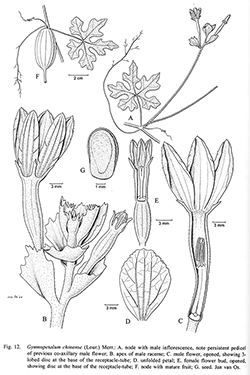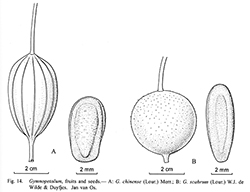e-Flora of Thailand
Volume 9 > Part 4 > Year 2008 > Page 443 > Cucurbitaceae > Gymnopetalum
1. Gymnopetalum chinense (Lour.) Merr.wfo-0000712769
Philipp. J. Sci. 256. 1919; S.K.Chen in C.Y.Wu, C.Chen & S.K.Chen, Fl. Yunnan. 6: 345, f. 90: 1–5. 1995; W.J.de Wilde & Duyfjes, Blumea 51: 283.— Evonymus chinensis Lour., Fl. Cochinch. 156. 1790. Fig. 12; 14: A.
Accepted Name : Trichosanthes costata Blume
Bijdr. Fl. Ned. Ind.: 933. 1826.
Synonyms & Citations :
Description : Climbing or creeping herb, rooting at the nodes, to 6 m long, finely scabrous and sparsely hairy or subglabrous. Probract (minute, caducous or) absent. Tendrils unbranched. Leaves: blade ovate, or triangular in outline, or 3- or 5-angled or (deeply) lobed, 4–12 cm diam., membranous, ± sparsely scabrous-pubescent on both surfaces, upper surface not bullate, cystoliths usually faint, or fine, base deeply cordate, margin finely sparsely dentate, apex acute(-acuminate), main veins 5, subpalmate; petiole 2–5 cm long. Male inflorescences: flowers solitary or severral in erect racemes 10–25 cm long, bracteate, sometimes co-axillary with a solitary flower; peduncle 4–12 cm long; bracts oblong, 15–20 mm long, (deeply) 2–5-lobed, base cuneate or rounded, sessile, without glands. Male flowers thinly grey pubescent; pedicel 3–7 cm long for solitary flowers, 5–15 mm long in the racemes, faintly articulate with receptacle; receptacle-tube narrow, but widened in upper ⅓ where containing the synandrium, 25–35 mm long, 3–4(–5) mm wide at throat, outside and inside ± pubescent, throat yellow inside; sepals linear, rarely ± lobed, 6–9 mm long, spreading to recurved, green; petals obovate, short-clawed, 20–30 by 12–15 mm, indistinctly veined, somewhat hairy, yellow at base; stamens inserted 12–15 mm below receptacle throat, filaments short, synandrium 9–10 by ca 3.5 mm, deeply included, connectives not enlarged; disc short, 3-lobed. Female flowers: perianth as in male flowers; pedicel 0.5–2(–4) cm long; ovary narrowly ellipsoid, 10–12 by 2.5–4 mm, pubescent, (faintly) 10-ribbed; style 18–20 mm long; stigmas 4–6 mm long, included; disc low, ± 3-lobed. Fruits broadly fusiform, 2.5–5 by 1.5–3 cm, beaked by receptacle remnant, orange-red, glabrescent, sharply 10-ribbed, pulp greenish (brown); fruiting pedicel 1–4 cm long. Seeds oblong, 7–8 by 2–3 by 1.5 mm, with marginal groove, faces not ornamented.
Thailand : Known from all provinces.
Distribution : Widespread: north-eastern part of India, China, through Indochina (type), east to Sumatra, Peninsular Malaysia, Borneo, Java, the Philippines, Celebes, Lesser Sunda Islands east to Flores.
Ecology : forests edges, clearings, scrub, in hedges and in open fields, 0–1,000 m alt. Flowering and fruiting throughout the year.
Vernacular : Kadom (กะดอม)(Central); khi ka dong (ขี้กาดง)(Saraburi); khi ka noi (ขี้กาน้อย)(Saraburi); khi ka lai (ขี้กาลาย)(Nakhon Ratchasima); khi ka liam(ขี้กาเหลี่ยม)(Northeastern); phak khaep pa (ผักแคบป่า)(Nan); fak khao (ฟักขาว)(Chiang Mai); manoi cha (มะนอยจา)(Northern); manoi hok (มะนอยหก), manoi hok fa (มะนอยหกฟ้า)(Mae Hong Son).
Notes: The flowers of Gymnopetalum chinense open at night and wilt by the following morning.


